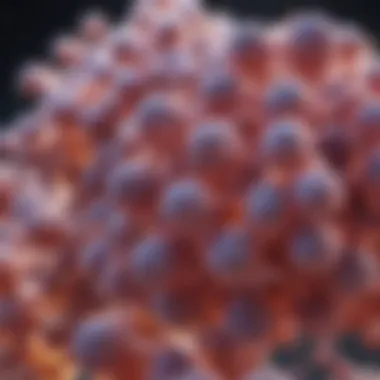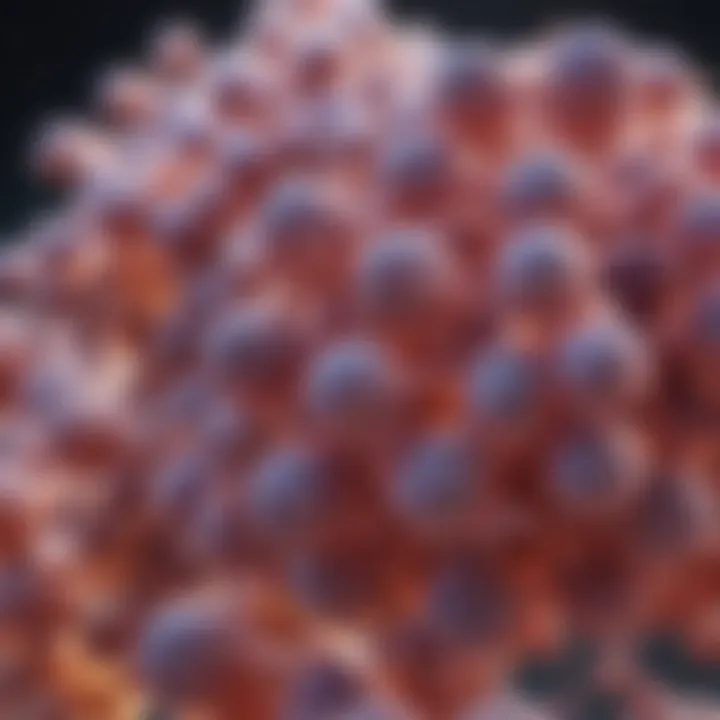Implications of Low IgE Levels on Allergy Responses


Intro
This article delves into the topic of low Immunoglobulin E (IgE) levels and their role in allergy responses. IgE is a crucial antibody in the body’s immune response, primarily involved in allergic reactions. When understanding how low levels of this antibody might influence allergy manifestation, it is essential to consider various biological, clinical, and health dimensions. The complexity surrounding IgE levels deserves careful scrutiny to better explain allergies' diverse presentations and implications for diagnosis and treatment.
Research Overview
Key Findings
Recent studies have highlighted several key observations regarding low IgE levels and their implications for allergy responses. Notably,
- IgE mediates allergic reactions: It serves as the primary mediator between allergens and immune responses.
- Low levels can indicate specific health conditions: Conditions such as immunodeficiency or certain autoimmune disorders may be associated with naturally low IgE levels.
- Variation in allergic responses: Individuals with low IgE levels may exhibit atypical allergy symptoms, complicating diagnosis.
These findings underscore the importance of understanding low IgE levels in clinical practice, especially in allergy diagnostics.
Study Methodology
The investigations surrounding IgE have employed various research methodologies. Common approaches include:
- Serum IgE testing: Analysis of blood samples to determine IgE concentrations.
- Clinical trials: Observational studies assessing patient responses to allergens and their corresponding IgE levels.
- Longitudinal studies: Tracking changes in IgE levels over time in response to environmental factors and treatments.
Such methodologies are critical for obtaining a comprehensive understanding of the dynamics of low IgE levels and their relation to allergies.
Background and Context
Historical Background
The exploration of IgE began in the 1960s when researchers identified its role in allergic reactions. Initial studies concentrated on its mechanisms but did not sufficiently address the implications of low IgE levels. Over time, a growing body of literature has explored the diverse roles of this antibody, revealing its complexity beyond typical allergic responses.
Current Trends in the Field
Currently, there is an increasing focus on how low IgE levels correlate with various health outcomes. Scholars are examining how these levels can affect patient management, particularly in those diagnosed with allergies. Technologies for precise IgE measurement, alongside advancements in immunology, are allowing more nuanced insights into how low levels contribute to health.
Understanding low IgE levels could pave the way for improved diagnostic processes and targeted therapies for allergy management.
Prolusion to Immunoglobulin E
Understanding Immunoglobulin E (IgE) is crucial as it relates directly to allergy responses. IgE plays a significant role in how the body reacts to various allergens. By delving into this topic, we can uncover the biological mechanisms that underpin allergies and the implications of IgE levels on health outcomes. This section will serve as a foundation for discussing low IgE levels and their impact on allergic reactions.
Definition and Role of IgE
Immunoglobulin E is a type of antibody produced by the immune system. Specifically, it is synthesized by B cells and is predominant in allergic reactions. IgE levels can fluctuate based on exposure to allergens. Its main function is to recognize and bind to allergens, facilitating the activation of other immune responses. When an allergen is encountered, IgE triggers the release of histamines and other chemicals from mast cells and basophils. This release produces the typical symptoms associated with allergies, such as sneezing, itching, and inflammation. Thus, IgE is vital not just in causing allergic reactions but also in the immune protection against parasitic infections.
The Immune System and Allergy
The immune system plays an integral role in maintaining health. It identifies and combats foreign substances, including viruses, bacteria, and allergens. Allergies are a result of an overactive immune response to harmless substances. The pathological role of IgE in allergies becomes evident during these responses. Upon the first exposure to an allergen, the immune system sensitizes itself, preparing IgE antibodies. On subsequent exposures, these antibodies interact with the allergen, leading to a cascade of immune reactions. This unintended hypersensitivity can cause various allergic conditions, illustrating the critical relationship between IgE levels and allergic responses.
Mechanisms of IgE Production
The study of Immunoglobulin E (IgE) production is crucial for grasping the underlying mechanisms of allergy responses. IgE is a type of antibody essential for the immune system’s reaction to allergens. Understanding how IgE is produced reveals significant insights into allergic conditions and their management. This section focuses on two key aspects: the role of B cells and the influence of antigens in IgE synthesis.
B Cells and Class Switching
B cells are a type of white blood cell that plays a vital role in the immune response. These cells are responsible for producing antibodies, including IgE, which is specifically associated with allergic reactions. The process of class switching is fundamental in the production of IgE. During this process, B cells change the isotype of antibody they produce without altering the antigen specificity.
Key Steps in Class Switching for IgE:
- A mature B cell initially produces Immunoglobulin M (IgM).
- Upon activation by helper T cells, B cells can undergo class switching to produce different types, including IgE.
- The cytokine interleukin-4 (IL-4) is integral as it stimulates the B cells to switch to IgE production.
This mechanism ensures that when an individual encounters an allergen, their immune system can respond effectively by generating IgE. The presence of IgE leads to the activation of mast cells and basophils, which release histamines and other chemicals that contribute to allergic symptoms.
Role of Antigens in IgE Synthesis
Antigens are substances that provoke an immune response. In the context of allergies, they are typically proteins found in allergens such as pollen, dust mites, and certain foods. When these antigens enter the body, they are recognized by B cells, prompting the initiation of IgE synthesis.
The interaction between B cells and antigens occurs through specific receptors on the B cell surface. Once an antigen binds to these receptors, the B cell becomes activated.
Factors Influencing Antigen-Induced IgE Synthesis:


- Type of Allergen: Different allergens can stimulate varying levels of IgE.
- Genetic Predisposition: Some individuals may be genetically predisposed to produce higher levels of IgE when exposed to specific antigens.
- The Immune Environment: Factors such as the presence of other cytokines can enhance or inhibit IgE production.
Understanding these mechanisms helps in identifying pathways that lead to allergic reactions. By addressing the ways in which B cells and antigens interact to produce IgE, researchers can develop targeted therapies or interventions to mitigate allergic responses.
"The role of B cells and antigens is crucial in the production of IgE, which directly influences how the body responds to allergens."
By dissecting the mechanisms of IgE production, health professionals can better diagnose allergies and develop new treatments for individuals with atypical IgE levels. This knowledge not only aids in managing existing allergic diseases but also informs future research directed at preventing these conditions.
Clinical Significance of IgE Levels
Understanding IgE levels is crucial in the realm of immunology and allergy diagnostics. IgE, or immunoglobulin E, plays a vital role in the body's immune response to allergens. Its levels can provide insights into an individual’s atopic status and potential allergic responses. Knowing the significance of both normal and low IgE levels helps clinicians and researchers tailor approaches to diagnosis and treatment.
Recognizing the clinical significance of IgE levels involves several important considerations:
- Diagnosis and Monitoring: IgE levels are frequently measured in patients presenting with allergic symptoms. Elevated IgE levels often indicate sensitization to allergens. Conversely, low levels can suggest a different immune profile, warranting further investigation.
- Disease Association: Low IgE levels could point towards various conditions, including certain immunodeficiencies or non-allergic conditions. Identifying such associations can lead to better overall patient management.
- Predictive Value in Therapies: Understanding individual IgE levels can illuminate not only the likelihood of allergic reactions but also the effectiveness of certain therapies. For instance, individuals with low IgE might respond differently to immunotherapy.
In summary, the clinical significance of IgE levels is multifaceted. It offers insights that go beyond mere numbers, serving as a critical indicator in managing allergies and understanding immune responses.
Normal Versus Low IgE Levels
Normal IgE levels typically range between 0 and 100 IU/mL in the general population, but this can vary based on age and individual health conditions. Elevated IgE levels often correlate with allergic diseases such as asthma, allergic rhinitis, and eczema. In contrast, low IgE levels can indicate a lack of sensitization to common allergens, but they also raise questions about overall immune health.
Some points to consider regarding normal versus low IgE levels include:
- Diversity in Immune Response: Individuals can have normal IgE levels yet still experience allergies. This highlights that IgE is not the sole player in allergic responses. Other components of the immune system are also involved.
- Context Matters: A low IgE level does not automatically imply an absence of allergies. Some individuals may have a rare form of hypo-IgE syndrome, which could mean they are at risk for infections and other immune-related challenges despite their low levels.
- Potential Benefits: In some cases, having low IgE levels can confer an advantage, as individuals may be less likely to experience severe allergic reactions.
IgE Levels in Allergy Testing
Allergy testing typically includes measuring IgE concentrations in response to specific allergens. Skin prick tests and serum-specific IgE tests are common methods. The results can reveal a wealth of information about a person's sensitivity to various environmental triggers.
Key aspects of IgE levels in allergy testing include:
- Sensitivity and Specificity: Elevated IgE levels in response to specific allergens can support a diagnosis of atopic diseases. This is crucial for developing a personalized management plan.
- Screening Tool: Testing IgE levels aids in screening patients, helping to identify which allergens to avoid to minimize symptoms.
- Limitations of Testing: Low IgE levels may not always exclude the possibility of allergies. Some allergic reactions could be mediated through non-IgE mechanisms, which standard testing might not detect.
Takeaway: The interpretation of IgE levels must be contextualized within the broader clinical scenario, as low IgE levels may not equate to the absence of allergic conditions. It is imperative for healthcare providers to understand detailed immunological responses when evaluating these tests.
Understanding Low IgE Levels in Allergies
Low Immunoglobulin E (IgE) levels play a crucial role in allergy responses, offering insights that extend beyond a simplistic understanding of allergy mechanisms. The presence or absence of IgE is significant in diagnosing and managing allergic conditions. Understanding these low levels helps in evaluating patients who exhibit symptoms of allergy without the typical IgE elevation. It sheds light on non-allergic conditions and can assist healthcare providers in tailoring more precise treatment plans.
When Low IgE Suggests Non-Allergic Conditions
Low IgE levels may indicate various non-allergic conditions. In some cases, these conditions may mimic allergic responses but do not stem from the typical pathways associated with IgE-mediated mechanisms. Certain autoimmune disorders, such as lupus or rheumatoid arthritis, might show low levels of IgE, creating diagnostic challenges. Furthermore, individuals with hyperIgM syndrome present with low IgE, implying that a healthy immune response may be compromised, which could lead to a vulnerability to infections rather than allergies.
Key points include:
- Distinct Immune Responses: Understanding that low IgE does not always point to an allergy allows for greater nuance in clinical settings.
- Immunological Disorders: Disorders like primary immunodeficiency disorders often reflect low IgE levels, which can confuse the diagnostic process if allergies are suspected.
- Misleading Symptoms: Symptoms resembling allergies but resulting from infections or other immunological issues can lead to misdiagnosis without considering IgE levels.
"Low IgE levels can mislead providers, making it vital to investigate underlying causes beyond typical allergy tests."
Impact on Allergic Sensitization
When IgE levels are low, the implications for allergic sensitization are significant. Typically, IgE antibodies rise in response to allergens, promoting allergic symptoms through histamine release and promoting inflammation. However, if a patient presents with low IgE levels, it suggests a reduced capacity for allergen sensitization.
This reduced capacity can lead to a lack of awareness regarding potential allergens, possibly increasing the risk of unrecognized allergic reactions in the future. Individuals may not react as expected to allergenic substances. For example, a person with low IgE might consume certain foods that are typically allergens without immediate hypersensitivity, thus experiencing delayed or atypical reactions.
Consider the following:
- Altered Sensitization Patterns: Reduced IgE can reshape the way allergens interact with the immune system, leading to unexpected reactions.
- Complex Interplay: The immune system's ability to tolerate certain allergens could be affected by the individual's overall health and genetic factors.
- Long-Term Effects: Continued exposure to allergens without a typical IgE response may result in complex immune behavior over time, which demands closer observation as allergic responses can change.
In summary, the presence of low IgE levels warrants careful scrutiny, influencing both the understanding of allergy responses and the clinical approach to managing patient care.
Potential Causes of Low IgE Levels
Understanding the underlying causes of low Immunoglobulin E (IgE) levels is critical in allergy research and clinical practice. Low IgE is often overlooked, but it can provide insights beyond allergies. Identifying potential reasons helps in differential diagnoses, leading to better patient management and tailored approaches. This section delves into various factors that can lead to decreased IgE, focusing on genetic influences, infections, and medicational impacts.
Genetic Factors
Genetic predisposition plays a significant role in determining IgE levels. Some individuals may possess inherited traits that lead to naturally lower production of IgE. Studies have shown that certain polymorphisms in key genes involved in immune regulation can affect IgE synthesis. For instance, variations in the IL-4 gene can influence the body’s ability to produce IgE. Research indicates that heritable traits can establish the baseline level of IgE in various populations.


Furthermore, certain conditions, like hyper IgE syndrome, are linked to mutations in the STAT3 gene. Although this is associated with excessive IgE in some cases, it reflects the broader spectrum of immunological regulation where genetic factors are prominent. Understanding these influences allows healthcare professionals to assess and interpret IgE levels in their patients more accurately, offering insights into the immune profile of individuals.
Infections and Immune Health
Infections, especially during early childhood, can affect the immune system's development and function. Viral infections may suppress IgE production temporarily or shift the immune response. For example, respiratory viruses can modify the T immune response, reducing the likelihood of allergic sensitization. Conditions like these can mislead clinicians into misinterpreting low IgE as a sign of insufficient immune response when it may signify an adaptive process to prior infections.
Chronic infections can also play a significant role in immune modulation. Persistent immune activation may lead to alterations in typical immune responses, including IgE synthesis. Hence, understanding the patient's infection history is crucial when evaluating low IgE levels. Monitoring infections and their timing concerning IgE measurement is essential for accurate clinical assessments.
Medication Influences
Medications can significantly impact IgE levels by modifying immune function. Corticosteroids, for instance, are known to reduce allergic responses and can lead to decreased IgE production. Patients on these medications may show low IgE levels during routine allergy testing, creating confusion regarding allergic status.
Other medications like antihistamines and immunosuppressants may also impact immune regulation. They often dampen various immune responses, including those associated with IgE. It is essential for clinicians to take medication histories into account when interpreting IgE results.
Health Implications of Low IgE Levels
Understanding the health implications of low Immunoglobulin E (IgE) levels is crucial as this condition can shed light on various underlying health issues. The relationship between low IgE levels and health outcomes is not straightforward, as it may indicate both potential deficiencies and atypical immunological responses. Two major areas of concern related to low IgE levels are malnutrition and autoimmune conditions.
Associations with Malnutrition
Malnutrition can have a profound impact on immune function. Individuals with low IgE levels may often experience nutritional deficiencies, which can hinder the immune system's ability to respond appropriately to allergens.
- Nutritional Deficiencies: Low IgE can be associated with inadequate intake of essential nutrients. For instance, deficiencies in vitamins A, C, D, or E can disturb immune regulation, affecting IgE production.
- Immune Response: When IgE levels are low, the body's ability to produce effective immune responses to pathogens may become compromised. This could increase susceptibility to infections, which is particularly concerning for vulnerable populations such as children and the elderly.
- Detection and Management: It is essential to assess nutritional status in individuals with low IgE, as addressing any deficiencies can potentially enhance immune function. Healthcare professionals may use dietary interventions focused on nutrient-rich foods to help improve overall health.
Autoimmune Conditions
Low IgE levels can also have implications for autoimmune conditions. Typically, autoimmune diseases involve an overactive immune system that mistakenly attacks healthy cells. However, in certain conditions, a decreased level of IgE may also be observed.
- Implications for Diagnosis: Low IgE can complicate the diagnosis of autoimmune disorders. Patients with autoimmune conditions may present with low IgE levels, which could lead to misinterpretation of their allergic responses. Therefore, a comprehensive evaluation is necessary to distinguish between true allergic reactions and autoimmune processes.
- Management Considerations: Managing low IgE levels in the context of autoimmune diseases often requires a multifaceted approach. Immunosuppressive medications might be considered to regulate immune responses, but these treatments can further affect IgE production.
In summary, low IgE levels have significant health implications. They may indicate underlying issues such as malnutrition or autoimmune conditions, necessitating further investigation and tailored management strategies. Addressing these concerns is important for improving the overall health and well-being of affected individuals.
"Considering IgE levels provides essential insights into the immune system functionality, especially concerning allergies and other immunological disorders."
The intricate relationship between low IgE levels and various health conditions underlines the necessity for further research. This exploration not only benefits clinicians in making informed decisions but also paves the way for understanding the broader implications of immunological responses.
Low IgE in Pediatric Populations
Low IgE levels in pediatric populations represent a critical area of interest in the field of immunology and allergy research. During childhood, the immune system undergoes significant development, making it essential to understand how low IgE levels can influence health outcomes. Concentrating on low IgE in children can yield insights into how these levels may correlate with allergy responses and general immune functionality. Notably, this understanding can aid in better diagnostics, improve preventive strategies, and ultimately enhance the quality of life for affected children.
Developmental Perspectives
The developmental stage of a child is pivotal when examining low IgE levels. At infancy, the immune system is immature; thus, immunoglobulin levels—including IgE—can fluctuate widely. Since IgE is crucial in mediating allergic reactions, children with low IgE levels may present with atypical allergic profiles. For instance:
- The immune system's response to common allergens can differ significantly from older children or adults.
- Children with low IgE levels might experience fewer allergic reactions, but this does not necessarily indicate complete immunity.
Moreover, understanding how low IgE levels manifest during various developmental phases can help doctors and researchers create tailored interventions. It allows them to distinguish between transient and persistent conditions that may affect long-term immune health.
Impact on Childhood Allergies
Low IgE levels play a unique role in childhood allergies. Some studies suggest that low IgE may indicate a different immunologic pathway in response to allergens. It raises questions about sensitivity, exposure, and overall immune responses. Key impacts include:
- Underdiagnosis of Allergies: Children with low IgE may not exhibit typical allergic responses, leading to false negatives in allergy tests.
- Diverse Allergy Profiles: Such children may respond to fewer allergens or develop allergies later in life, prompting a need for different monitoring strategies.
- Potential Health Risks: While low IgE can mean lower allergy risk, it may also be associated with autoimmune diseases or chronic infections due to an imbalanced immune system.
Understanding how pediatric populations react to low IgE levels provides valuable insights that could reshape current diagnostic methodologies and clinical approaches.
Ultimately, comprehending low IgE levels in children warrants significant attention as it can offer insights into their immune development and implications for allergy management.
Diagnostic Approaches for Low IgE Levels
In the context of low Immunoglobulin E (IgE) levels, diagnostic approaches play a vital role in understanding the underlying issues related to allergies and immune health. Establishing low IgE levels is not merely a matter of identifying a number on a test report. Rather, it serves as an entry point into deeper assessments of immunological status, patient history, and potential health implications.
The identification of low IgE can help clinicians differentiate between allergic and non-allergic conditions. This distinction is crucial, as it guides further management and treatment strategies. A variety of diagnostic tests are available to measure IgE levels, each with its own advantages and challenges. Understanding these modalities allows for better interpretation of results and informs appropriate follow-up actions.
Laboratory Tests for IgE Measurement
Laboratory tests for measuring IgE levels are the cornerstone of diagnostics in this field. The most common test is the serum IgE test, which provides a quantitative measurement of IgE antibodies in the blood. Techniques such as enzyme-linked immunosorbent assays (ELISA) are often utilized in these evaluations.
More specialized tests can focus on specific allergens to assess whether the body is producing IgE in response to particular substances. These may include:


- Skin prick tests: These are used to determine hypersensitivity to specific allergens by introducing small amounts into the skin.
- Radioallergosorbent tests (RAST): These measure specific IgE antibodies against allergens in the blood.
It is important to consider factors such as age, personal medical history, and even genetic background when interpreting IgE levels. A low IgE result does not automatically rule out allergic diseases. Therefore, a comprehensive understanding of all available tests can guide clinicians toward more accurate diagnoses.
Differentiating Allergic and Non-Allergic Responses
Understanding the distinction between allergic and non-allergic responses is crucial in allergology. Low IgE levels can present in various clinical contexts, and differentiating between these conditions requires thorough evaluation.
- Allergic responses are typically characterized by the production of IgE upon exposure to allergens. When IgE levels are low, it may indicate a lack of sensitization, which can confuse the diagnostic landscape.
- Non-allergic responses can manifest similarly to allergies but without the IgE-mediated pathway. These conditions may involve other immune mechanisms and require different therapeutic approaches.
Clinicians should take detailed patient history and symptom evaluations into account, focusing on factors such as:
- Symptoms’ onset and duration: Identifying patterns can shed light on potential allergic triggers.
- Environmental exposures: Understanding a patient's environment offers insights into the possibility of triggers or irritants.
- Response to medications: Observing how symptoms change with medications can help in understanding underlying conditions.
In summary, diagnostic approaches for low IgE levels are comprehensive and multi-faceted. By utilizing various testing methodologies and by differentiating between allergic and non-allergic responses, healthcare providers can gain invaluable insights into allergy profiles and immune health. This knowledge ultimately assists in tailoring management strategies that are both effective and specific to individual patient needs.
Management Strategies for Low IgE Levels
Understanding how to manage low Immunoglobulin E (IgE) levels is essential for those affected by allergic responses and related ailments. While low IgE levels may suggest a decreased likelihood of allergies, their management can still have significant implications for a person's overall health. This section focuses on two critical aspects: nutritional and lifestyle modifications, as well as monitoring immune function. Both strategies lead to a more comprehensive approach to health by taking into account both immediate and long-term health goals.
Nutritional and Lifestyle Modifications
Nutritional strategies can bring substantial benefits when dealing with low IgE levels. A well-balanced diet supports overall immune function and can help in compensating for any deficiencies or imbalances in the immune system. Here are some nutritional elements to consider:
- Antioxidant-rich foods: Consuming fruits and vegetables high in antioxidants may aid in enhancing immune function. Options such as berries, spinach, and nuts are beneficial.
- Omega-3 fatty acids: Foods like fatty fish (salmon, mackerel) and flaxseeds can decrease inflammation and improve immune responses.
- Probiotics: Incorporating fermented foods like yogurt or sauerkraut can support gut health, which is closely tied to immune function.
Lifestyle modifications are likewise important. Regular physical activity can enhance overall health, reduce stress, and positively impact immune function. Engaging in moderate exercise, like walking or cycling, can constitute a strong foundation for immune health. Furthermore, good sleep hygiene plays a crucial role, as quality sleep directly influences immune resilience. Avoiding known allergens and irritants, such as tobacco smoke or pollutants, can further support this health balance.
Monitoring Immune Function
Monitoring immune function is pivotal when it comes to managing low IgE levels. Understanding how the immune system operates allows for more targeted actions to improve health. Regular check-ups with healthcare providers can help in tracking IgE levels and understanding their significance. Also, monitoring for any changes in symptoms or allergic reactions is crucial.
- Regular Testing: Scheduled blood tests can reveal fluctuations in IgE levels and other markers of immune function.
- Symptom Tracking: Keeping a detailed log of any new symptoms helps identify potential triggers and changes in health.
- Consulting Specialists: Working closely with immunologists or allergists can provide additional insights into specific immune challenges and effective management strategies.
"Understanding and managing low IgE levels should not be a passive process. Active engagement with healthcare providers and lifestyle choices can significantly influence health outcomes."
By integrating nutritional and lifestyle modifications with diligent monitoring of immune function, individuals with low IgE levels can develop a holistic strategy that addresses their health needs while promoting a balanced immune response. A proactive approach in these areas can lead to better management of symptoms and improved quality of life.
Future Research Directions
The area of low IgE levels and its implications for allergy responses holds significant potential for future research. Understanding the regulation of IgE production and the pathways involved in allergic reactions can pave the way for innovative diagnostic and therapeutic methods. This is especially true given the increasing prevalence of allergic diseases globally, prompting a need for deeper investigations into immunoglobulin responses.
Understanding IgE Regulation
Research in IgE regulation remains a critical aspect of immunological studies. IgE production is a result of complex interactions within the immune system. Future studies should focus on identifying the specific cellular and molecular mechanisms that lead to low IgE levels in individuals susceptible to allergies. This might involve investigating the role of cytokines, transcription factors, and epigenetic modifications in B cell activation and differentiation.
By analyzing these regulatory mechanisms, researchers can uncover potential biological markers that signify a predisposition to low IgE levels. These discoveries can help in crafting tailored interventions that could enhance IgE production or modulate immune response. Additionally, understanding these processes could significantly inform vaccine development aiming to enhance immunity without triggering unwanted allergic reactions.
Exploring Therapeutic Potentials
Examining the therapeutic potentials associated with low IgE levels presents another promising area for exploration. There is a growing interest in the development of treatments targeting IgE-mediated conditions. Research into monoclonal antibodies, such as Omalizumab, has already demonstrated the ability to alleviate symptoms in allergic patients.
Future investigations can aim to fine-tune such therapies or discover new compounds that modulate IgE levels more effectively. Furthermore, assessing how lifestyle factors, environmental exposures, and diet influence IgE regulation could provide clinicians with more comprehensive approaches to managing allergies.
Ultimately, the goal is to translate these findings into practical solutions that can reduce allergic responses in affected populations. As we gain a clearer view of low IgE responses and related pathways, effective strategies can emerge, contributing to enhanced patient care and improved quality of life for individuals with allergy conditions.
In summary, advancing research into IgE regulation and therapeutic options will enhance our understanding of allergic responses, offering prospects for more effective management and treatment strategies.
Summary and Culmination
In the examination of low Immunoglobulin E (IgE) levels and their association with allergy responses, it becomes evident that understanding this relationship holds significant implications for both clinical practice and research. Summarizing the key aspects discussed throughout the article, it is clear that low IgE levels can indicate a varied set of health conditions and responses. These levels provide insight not only into allergic reactions but also into immune system functionality.
The Role of IgE in Allergies
Immunoglobulin E plays a pivotal role in the immune system’s response to allergens. Typically, higher levels of IgE are associated with allergic reactions, as they facilitate the body's response to perceived threats. However, in cases of low IgE, the absence of this crucial immunoglobulin can suggest alternative pathways for immune responses.
Understanding the function of IgE helps in discerning why some individuals may not exhibit typical allergic symptoms despite exposure to allergens. This contrasts with individuals who produce higher levels of IgE and experience more robust allergic reactions. In this context, low IgE levels warrant further investigation, as they can reveal underlying immunological facets that would otherwise remain overlooked. The interplay of IgE with other immunoglobulin types is critical in accurately interpreting allergy susceptibility and overall immune health.
Final Thoughts on Low IgE Levels
A critical takeaway is the need for ongoing research directed towards elucidating the mechanisms governing IgE regulation and its implications on health. Furthermore, clinicians must consider the broader health context of their patients. By doing so, the overarching narrative around IgE levels shifts from a merely quantitative measure to a more intricate evaluation of the immune system’s health and resilience.
By integrating these insights, students, researchers, and health professionals can foster a more comprehensive approach for studying and treating allergy conditions, enhancing patient outcomes and advancing immunological knowledge.
A thorough understanding of IgE levels can reshape approaches to both allergies and general immune health.







